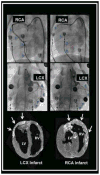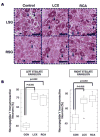Remodeling of stellate ganglion neurons after spatially targeted myocardial infarction: Neuropeptide and morphologic changes
- PMID: 25640636
- PMCID: PMC4411181
- DOI: 10.1016/j.hrthm.2015.01.045
Remodeling of stellate ganglion neurons after spatially targeted myocardial infarction: Neuropeptide and morphologic changes
Abstract
Background: Myocardial infarction (MI) induces remodeling in stellate ganglion neurons (SGNs).
Objective: We investigated whether infarct site has any impact on the laterality of morphologic changes or neuropeptide expression in stellate ganglia.
Methods: Yorkshire pigs underwent left circumflex coronary artery (LCX; n = 6) or right coronary artery (RCA; n = 6) occlusion to create left- and right-sided MI, respectively (control: n = 10). At 5 ± 1 weeks after MI, left and right stellate ganglia (LSG and RSG, respectively) were collected to determine neuronal size, as well as tyrosine hydroxylase (TH) and neuropeptide Y immunoreactivity.
Results: Compared with control, LCX and RCA MIs increased mean neuronal size in the LSG (451 ± 25 vs 650 ± 34 vs 577 ± 55 μm(2), respectively; P = .0012) and RSG (433 ± 22 vs 646 ± 42 vs 530 ± 41 μm(2), respectively; P = .002). TH immunoreactivity was present in the majority of SGNs. Both LCX and RCA MIs were associated with significant decreases in the percentage of TH-negative SGNs, from 2.58% ± 0.2% in controls to 1.26% ± 0.3% and 0.7% ± 0.3% in animals with LCX and RCA MI, respectively, for LSG (P = .001) and from 3.02% ± 0.4% in controls to 1.36% ± 0.3% and 0.68% ± 0.2% in LCX and RCA MI, respectively, for RSG (P = .002). Both TH-negative and TH-positive neurons increased in size after LCX and RCA MI. Neuropeptide Y immunoreactivity was also increased significantly by LCX and RCA MI in both ganglia.
Conclusion: Left- and right-sided MIs equally induced morphologic and neurochemical changes in LSG and RSG neurons, independent of infarct site. These data indicate that afferent signals transduced after MI result in bilateral changes and provide a rationale for bilateral interventions targeting the sympathetic chain for arrhythmia modulation.
Keywords: Autonomic nervous system; Myocardial infarction; Neuronal remodeling; Neuropeptide remodeling; Sympathetic ganglia.
Copyright © 2015 Heart Rhythm Society. Published by Elsevier Inc. All rights reserved.
Conflict of interest statement
Conflict of Interest : The authors have no conflicts of interest to disclose.
Figures







References
-
- Schwartz PJ. Cardiac sympathetic denervation to prevent life-threatening arrhythmias. Nature reviews Cardiology. 2014;11:346–353. - PubMed
-
- Shen MJ, Zipes DP. Role of the autonomic nervous system in modulating cardiac arrhythmias. Circulation Research. 2014;114:1004–1021. - PubMed
-
- Bourke T, Vaseghi M, Michowitz Y, Sankhla V, Shah M, Swapna N, Boyle NG, Mahajan A, Narasimhan C, Lokhandwala Y, Shivkumar K. Neuraxial modulation for refractory ventricular arrhythmias: value of thoracic epidural anesthesia and surgical left cardiac sympathetic denervation. Circulation. 2010;121:2255–2262. - PMC - PubMed
Publication types
MeSH terms
Substances
Grants and funding
LinkOut - more resources
Full Text Sources
Other Literature Sources
Medical

